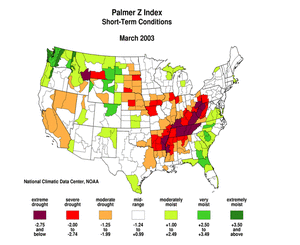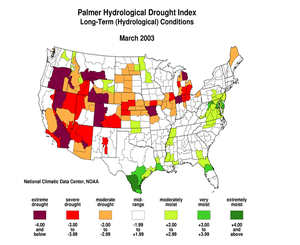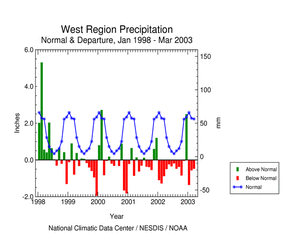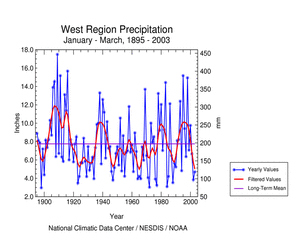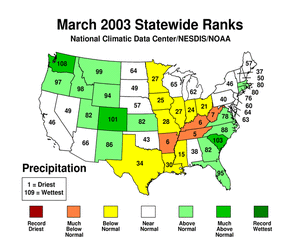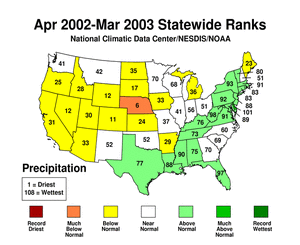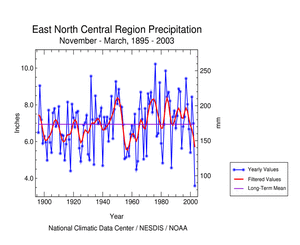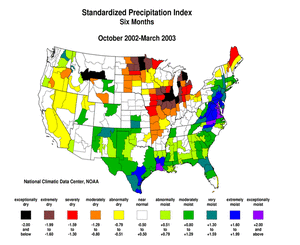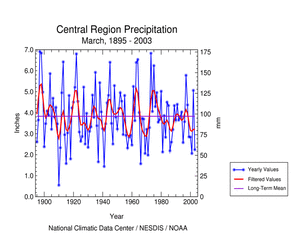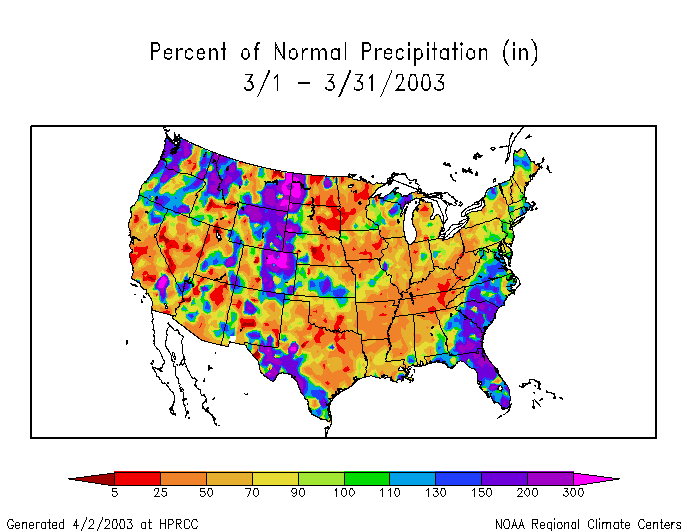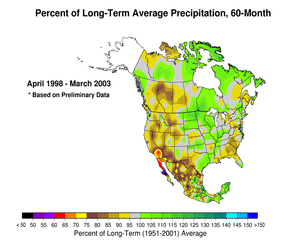U.S. Drought Highlights:
- On the national scale, severe to extreme drought affected about 16 percent of the contiguous United States as of the end of March 2003
- moderate to extreme drought affected about 30 percent of the contiguous U.S.
- Short-term conditions were dry from the central Appalachians to the southern Great Plains and continued dry across parts of the Midwest to central and northern Plains and Far West
- Unusually wet March conditions brought short-term relief to much of the Rockies and Pacific Northwest, but long-term drought continued across much of the West and from the central Plains to Great Lakes
Please Note: The data presented in this drought report are preliminary. Ranks, anomalies, and percent areas may change as more complete data are received and processed.
National Overview
On the national scale,
- about 30 percent of the contiguous U.S. fell in the moderate to extreme drought categories (based on the Palmer Drought Index) at the end of March;
- severe to extreme drought affected about 16 percent of the contiguous United States as of the end of March 2003, a decrease of about 2 percent compared to last month;
- the coverage of the current (November 1999-present) national-scale drought first peaked in August 2000 at about 36% of the contiguous U.S. (in the severe to extreme categories), which was as extensive as the major droughts of the last 40 years, but not as large as the "dust bowl" droughts of the 1930s and 1950s;
- the total drought area decreased to about 10 percent by November 2000, but had a general increasing trend for much of the period since then, reaching in July 2002 the peak it had first reached in August 2000; there has been a generally decreasing trend in drought area since July 2002 (see graph below left);
- on a broad scale, the last two decades were characterized by unusual wetness with short periods of extensive droughts, whereas the 1930s and 1950s were characterized by prolonged periods of extensive droughts with little wetness (see graph below right);
- although various parts of the U.S. have experienced unusually wet conditions during the last 41 months, little change occurred in the aggregate national wetness picture during much of this period;
- the percentage of the nation severely wet has remained below about eleven percent during this period, dropping to about 2 percent by the end of March 2003 (see graph below left);
- a file containing the national monthly percent area severely dry and wet from 1900 to present is available;
- historical temperature, precipitation, and Palmer drought data from 1895 to present for climate divisions, states, and regions in the contiguous U.S. are available at the Climate Division: Temperature-Precipitation-Drought Data page in files having names that start with "drd964x" and ending with "txt"(without the quotes).
Although some areas of the country were dry this month, other areas were wet. Integrated across the nation, March 2003 precipitation averaged slightly below normal, ranking as the 51st driest March in the 1895-2003 record. But the near-record dry January pulls the January - March 2003 rank down to 26th driest.
Regional Overview
- Above-normal precipitation fell across many western U.S. drought areas during March 2003, while others in the Great Plains and Midwest received below-normal precipitation.
- March was dry from the central Appalachians to the southern Plains and over parts of California and Nevada
- Much of the Great Lakes to northern Plains region had a fifth consecutive dry month.
- Most of the primary stations in Alaska, Hawaii, and Puerto Rico had drier than normal conditions during March
- Long-term drought continued in a band from the southern Great Lakes to the central Plains and across much of the West
A percent of normal precipitation map for March, created by the NOAA Regional Climate Centers (HPRCC) from Cooperative Network station data, shows greater detail of the spatial variability of the moisture anomalies.
The long-term dryness is also evident in the pattern of snowfall anomalies. Season-to-date (July 1, 2002 - April 9, 2003) snowfall has totaled below the long-term average across much of the Far West, central and northern Great Plains, and Great Lakes regions.
Western U.S. Drought
March 2003 marked the third consecutive month with below-normal precipitation, regionwide, for the West region, resulting in the 20th driest January-March on record. In fact, of the last 12 months, only December averaged wetter than normal, giving the region the 29th driest April-March.
Across much of the rest of the western U.S. drought areas, however, above-normal rain and snow fell. March was the second consecutive month with above-normal precipitation averaged across the Southwest region, and 3 of the last 4 months were wetter than normal for the Pacific Northwest. But long-term moisture deficits remained. The 12-month period, April 2002-March 2003, ranked as the 27th driest for the Southwest, 25th driest for the Northwest, and tenth driest for the West North Central region.
A major winter storm brought near-record rain and snow to a large part of Colorado during the month, resulting in the ninth wettest March, statewide, in the 109-year record. However, long-term moisture deficits were so great that the state still ranked as 11th driest for April 2002-March 2003.
Moderate to extreme drought still covered about 59% of the western U.S. (Rocky Mountains to west coast) at the end of March. These long-term drought conditions were reflected in below-average snow cover as monitored by snow course measurements, mountain SNOTEL station reports, and satellite observations, as well as by low reservoirs. The winter mountain snowpack is the source of spring meltwater which fills western reservoirs and is used for irrigation during the spring and summer growing seasons.
Central U.S. Drought
Although above-normal precipitation fell across parts of the upper Great Lakes, the East North Central region still averaged drier than normal, giving March 2003 a rank of 41st driest. This month marked the fifth consecutive below-normal month for the region, with November 2002-March 2003 ranking as the driest November-March, regionwide, on record. According to an analysis by NOAA's Midwest Regional Climate Center, a large part of the region had less than half the normal precipitation for November-March.
The dry conditions raised concerns about possible low levels for the Great Lakes later this summer. The U.S. Army Corps of Engineers predicted that, by July, all of the lakes are expected to be at or below their levels of 2001, which were the lowest since the record lows in 1964 (U.S. Water News Online).
Dry conditions from the central Appalachians to the southern Plains gave several states a March precipitation rank in the top ten driest category, along with a rank of twelfth driest for the Central region and 24th driest for the South region. Several wildfires had broken out in Arkansas, Oklahoma, and adjoining parts of Texas, scorching about 30,000 acres of vegetation by April 2.
The March dryness continued to significantly deplete soil moisture from the central Plains to the Great Lakes. This is evident in modeled soil moisture departures as computed by the NOAA Climate Prediction Center and the Midwest Regional Climate Center at both the top soil layers and deeper layers. Early April precipitation significantly improved moisture conditions in the top soil layers and helped improve conditions to some extent in the deeper layers.
Eastern U.S. Drought
March precipitation was near to above normal averaged across the Northeast and Southeast regions, although some stations in the interior Northeast were drier than normal. March averaged near normal across Maine, but dryness in both the short- and long-term gave the state the 14th driest January-March, eighth driest August-March, and 23rd driest April-March in the 109-year record. Long-term moisture deficits remained over the Carolinas and Georgia at the 24-month to 60-month timescales.
 NOAA's National Centers for Environmental Information
NOAA's National Centers for Environmental Information
